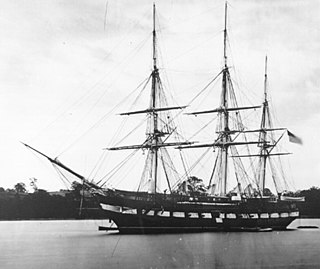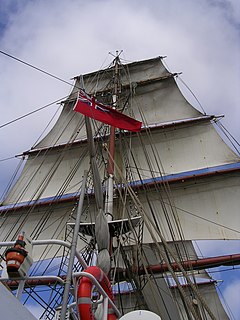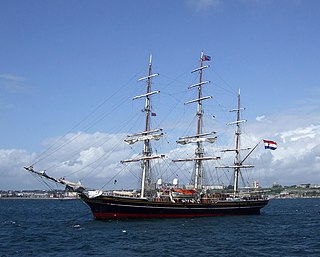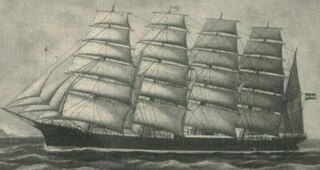
A sloop is a sailing boat with a single mast and a fore-and-aft rig. A sloop has only one head-sail; if a vessel has two or more head-sails, the term cutter is used, and its mast may be set further aft than on a sloop.

A schooner is a type of sailing vessel with fore-and-aft sails on two or more masts. The most common type has two masts, the foremast being shorter than the main. While the schooner was originally gaff-rigged, modern schooners typically carry a Bermuda rig.

A sail plan is a set of drawings, usually prepared by a naval architect which shows the various combinations of sail proposed for a sailing ship. Alternatively, as a term of art, it refers to the way such vessels are rigged as discussed below.

In the 18th century and most of the 19th, a sloop-of-war in the Royal Navy was a warship with a single gun deck that carried up to eighteen guns. The rating system covered all vessels with 20 guns and above; thus, the term sloop-of-war encompassed all the unrated combat vessels, including the very small gun-brigs and cutters. In technical terms, even the more specialised bomb vessels and fireships were classed as sloops-of-war, and in practice these were employed in the sloop role when not carrying out their specialized functions.

The mast of a sailing vessel is a tall spar, or arrangement of spars, erected more or less vertically on the centre-line of a ship or boat. Its purposes include carrying sail, spars, and derricks, and giving necessary height to a navigation light, look-out position, signal yard, control position, radio aerial or signal lamp. Large ships have several masts, with the size and configuration depending on the style of ship. Nearly all sailing masts are guyed.
While the majority of the clipper ships sailed under British and American flags, more than a hundred clippers were built in the Netherlands. They were medium clippers rather than the larger extreme clipper.

A Bermuda rig, Bermudian rig, or Marconi rig is a configuration of mast and rigging for a type of sailboat and is the typical configuration for most modern sailboats. This configuration was developed in Bermuda in the 17th century; the term Marconi was a reference to the inventor of the radio, Guglielmo Marconi, because the wires that stabilize the mast of a Bermuda rig reminded observers of the wires on early radio masts at a time when both were newly introduced.

Square rig is a generic type of sail and rigging arrangement in which the primary driving sails are carried on horizontal spars which are perpendicular, or square, to the keel of the vessel and to the masts. These spars are called yards and their tips, beyond the last stay, are called the yardarms. A ship mainly so rigged is called a square-rigger.

A full-rigged ship or fully rigged ship is a sailing vessel's sail plan with three or more masts, all of them square-rigged. A full-rigged ship is said to have a ship rig or be ship-rigged.

Blackadder was a clipper ship, a sister ship to Hallowe'en, built in 1870 by Maudslay, Sons & Field at Greenwich for Jock Willis & Sons.

The Stad Amsterdam is a three-masted clipper that was built in Amsterdam, the Netherlands, in 2000 at the Damen Shipyard.
Kosmopoliet I is said to have been one of the first Dutch clippers.

James Baines was a passenger clipper ship completely constructed of timber in the 1850s and launched on 25 July 1854 from the East Boston shipyard of the famous ship builder Donald McKay in the United States for the Black Ball Line of James Baines & Co., Liverpool. The clipper was one of the few known larger sailing ships rigged with a moonsail.

SkySails GmbH & Co. KG is a Hamburg-based company that sells kite rigs to propel cargo ships, large yachts and fishing vessels by wind energy. Ships are pulled by an automatically-controlled foil kite of some hundreds of square meters. For multiple reasons, they give many times the thrust per unit area of conventional mast-mounted sails.

Potosi was a five-masted steel barque built in 1895 by Joh. C. Tecklenborg ship yard in Geestemünde, Germany, for the sailing ship company F. Laeisz as a trading vessel. As its shipping route was between Germany and Chile, it was designed to be capable of withstanding the rough weather encountered around Cape Horn.
Wind assisted propulsion is the practice of decreasing the fuel consumption of a merchant vessel through the use of sails or some other wind capture device. Sails used to be the primary means of propelling ships, but with the advent of the steam engine and the diesel engine, sails came to be used for recreational sailing only. In recent years with increasing fuel costs and an increased focus on reducing emissions, there has been increased interest in harnessing the power of the wind to propel commercial ships.
The following outline is provided as an overview of and topical guide to sailing:
Kite rigs are wind-assisted propulsion systems for propelling a vehicle. They differ from conventional sails in that they are flown from kite control lines, not supported by masts.

HDMS Galathea was a three-masted corvette, build for the Danish Navy. It had a single, closed cannon deck and was equipped with 26 18-pound cannons, two of which where on the forecastle and two on the quarterdeck. It was a full-rigged ship, with royals and skysails on all three masts. However, the ship keeled over too much under all sails and the masts were shortened and sails reduced in 1844. The ship carried one longboat and four smaller boats.


















